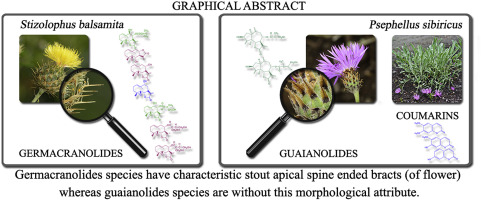当前位置:
X-MOL 学术
›
Phytochemistry
›
论文详情
Our official English website, www.x-mol.net, welcomes your
feedback! (Note: you will need to create a separate account there.)
Phytochemical profiles of the leaves of Stizolophus balsamita and Psephellus sibiricus and their chemotaxonomic implications
Phytochemistry ( IF 3.2 ) Pub Date : 2019-03-01 , DOI: 10.1016/j.phytochem.2018.12.022 Joanna Nawrot , Jaromir Budzianowski , Gerard Nowak
Phytochemistry ( IF 3.2 ) Pub Date : 2019-03-01 , DOI: 10.1016/j.phytochem.2018.12.022 Joanna Nawrot , Jaromir Budzianowski , Gerard Nowak

|
Seven germacranolides - balsamin, izospiciformin, stizolin, 9α-hydroxyparthenolide, 8α-E-(4'-hydroxy)-senecioyloxy-9α-hydroxyparthenolide, stizolicin and 11βH,13-dihydrostizolicin, as well as one undescribed phenol glycoside 3-(3,4-dihydroxyphenyl) propyl senecioate 3-O-β-glucopyranoside were isolated from the leaves of Stizolophus balsamita growing in Iran. Three coumarins, scoparone, scopoletin, umbelliferone and two guaianolides, cynaropicrin and desacylcynaropicrin 8α-(Z)-(4'-hydroxy-2'-methyl)butenoate (= cebellin F) were isolated from the leaves of Psephellus sibiricus. Phytochemical profile of Stizolophus balsamita growing in Iran differs from that of Stizolophus balsamita growing in Kazakhstan. Therefore, the taxonomic separation of Stizolophus balsamita from Iran is suggested. The results also suggest that isolated coumarins may be a chemotaxonomic marker of the Psephellus species. Moreover, the presence of germacranolides in Centaureinae species with stout apical spine ended bracts of flower (S. balsamita) and guaianolides in other species with appendages of the bracts without apical spine (P. sibiricus) suggests a possible connection between the chemical structure of the sesquiterpene lactones and morphology of flowers in the species of the Centaureinae subtribe. In addition, we propose a new 1H NMR approach for the detection of hydroxyl groups in sesquiterpene lactones.
中文翻译:

Stizolophus balsamita 和 Psepellus sibiricus 叶子的植物化学特征及其化学分类学意义
七种germacranolides - balsamin, izospiciformin, stizolin, 9α-hydroxyparthenolide, 8α-E-(4'-hydroxy)-senecioyloxy-9α-hydroxyparthenolide, stizolicin 和 11βH,13-dihydrostizolicin, 以及一种未描述的4-dihydroxyphenyl) 丙二酯 3-O-β-吡喃葡萄糖苷是从生长在伊朗的 Stizolophus balsamita 的叶子中分离出来的。从 Psepellus sibiricus 的叶子中分离出三种香豆素、scoparone、东莨菪碱、伞形酮和两种愈创木酚内酯、cynaropicrin 和 desacylcynaropicrin 8α-(Z)-(4'-hydroxy-2'-methyl)butenoate (= cebellin F)。生长在伊朗的 Stizolophus balsamita 的植物化学特征不同于生长在哈萨克斯坦的 Stizolophus balsamita。因此,建议将 Stizolophus balsamita 与伊朗进行分类分离。结果还表明,分离的香豆素可能是 Psepellus 物种的化学分类标记。此外,具有粗壮顶刺的 Centaureinae 物种(S. balsamita)和其他具有无顶刺的苞片附属物(P. sibiricus)的物种中的愈创木酚内酯的存在表明可能与花的化学结构之间存在联系。 Centaureinae亚部落物种中倍半萜内酯和花的形态。此外,我们提出了一种新的 1H NMR 方法来检测倍半萜内酯中的羟基。balsamita) 和其他物种中的愈创木酚内酯,苞片的附属物没有顶刺 (P. sibiricus) 表明倍半萜内酯的化学结构与 Centaureinae 亚部落物种中的花形态之间可能存在联系。此外,我们提出了一种新的 1H NMR 方法来检测倍半萜内酯中的羟基。balsamita) 和其他物种中的愈创木酚内酯,苞片的附属物没有顶刺 (P. sibiricus) 表明倍半萜内酯的化学结构与 Centaureinae 亚部落物种中的花形态之间可能存在联系。此外,我们提出了一种新的 1H NMR 方法来检测倍半萜内酯中的羟基。
更新日期:2019-03-01
中文翻译:

Stizolophus balsamita 和 Psepellus sibiricus 叶子的植物化学特征及其化学分类学意义
七种germacranolides - balsamin, izospiciformin, stizolin, 9α-hydroxyparthenolide, 8α-E-(4'-hydroxy)-senecioyloxy-9α-hydroxyparthenolide, stizolicin 和 11βH,13-dihydrostizolicin, 以及一种未描述的4-dihydroxyphenyl) 丙二酯 3-O-β-吡喃葡萄糖苷是从生长在伊朗的 Stizolophus balsamita 的叶子中分离出来的。从 Psepellus sibiricus 的叶子中分离出三种香豆素、scoparone、东莨菪碱、伞形酮和两种愈创木酚内酯、cynaropicrin 和 desacylcynaropicrin 8α-(Z)-(4'-hydroxy-2'-methyl)butenoate (= cebellin F)。生长在伊朗的 Stizolophus balsamita 的植物化学特征不同于生长在哈萨克斯坦的 Stizolophus balsamita。因此,建议将 Stizolophus balsamita 与伊朗进行分类分离。结果还表明,分离的香豆素可能是 Psepellus 物种的化学分类标记。此外,具有粗壮顶刺的 Centaureinae 物种(S. balsamita)和其他具有无顶刺的苞片附属物(P. sibiricus)的物种中的愈创木酚内酯的存在表明可能与花的化学结构之间存在联系。 Centaureinae亚部落物种中倍半萜内酯和花的形态。此外,我们提出了一种新的 1H NMR 方法来检测倍半萜内酯中的羟基。balsamita) 和其他物种中的愈创木酚内酯,苞片的附属物没有顶刺 (P. sibiricus) 表明倍半萜内酯的化学结构与 Centaureinae 亚部落物种中的花形态之间可能存在联系。此外,我们提出了一种新的 1H NMR 方法来检测倍半萜内酯中的羟基。balsamita) 和其他物种中的愈创木酚内酯,苞片的附属物没有顶刺 (P. sibiricus) 表明倍半萜内酯的化学结构与 Centaureinae 亚部落物种中的花形态之间可能存在联系。此外,我们提出了一种新的 1H NMR 方法来检测倍半萜内酯中的羟基。











































 京公网安备 11010802027423号
京公网安备 11010802027423号